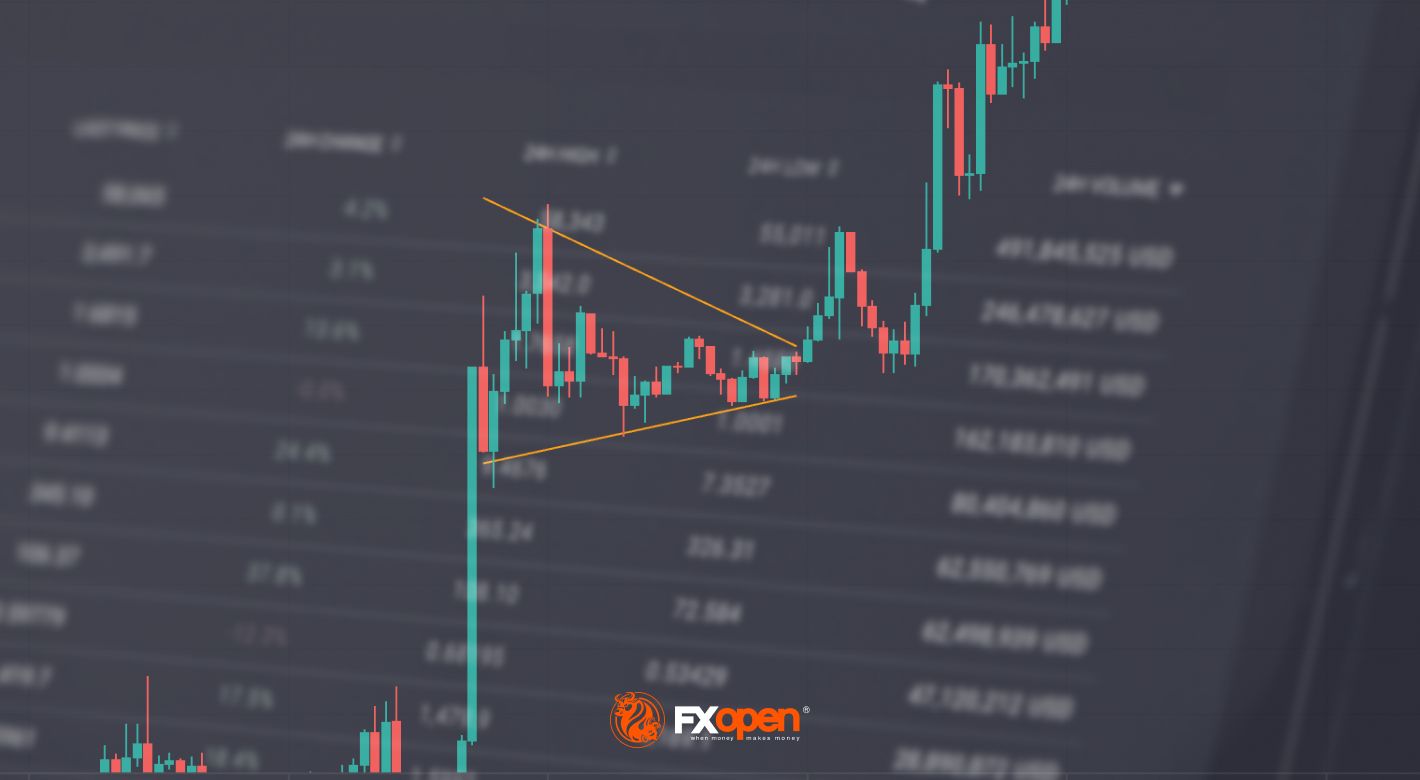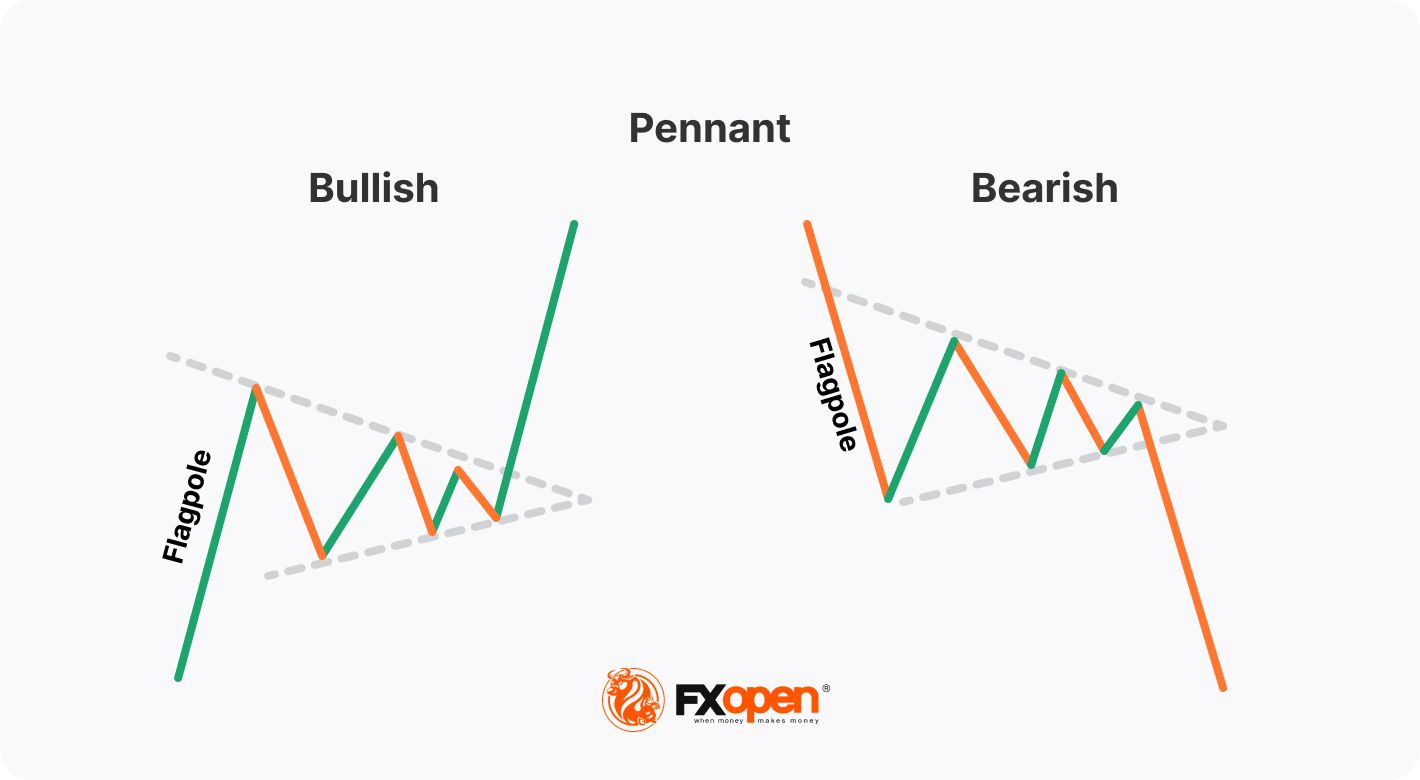FXOpen

As a trader, you're always searching for new ways to stay ahead in the market. One such tool is the pennant pattern, a popular technical analysis formation that can help you identify potential bullish or bearish trends in price. The pennant is a crucial aspect in a trader's toolkit, regardless of their level of experience.
By learning pennants, you will get an additional trading tool that will help you make informed trading decisions. In this FXOpen guide, we will discuss how to spot it and apply it in your trading.
What Are Pennant Chart Patterns?
A pennant is a continuation pattern that forms during a brief pause in the current trend. They are typically seen as a smaller version of a symmetrical triangle and have features of flags with a flagpole being commonly used to determine take-profit targets. This formation can be either bullish or bearish, depending on the direction of the overall trend. A bullish pennant pattern occurs during an uptrend and signals a continuation of a bullish trend, while a bearish pennant pattern signals a continuation of a bearish trend.

The formation is followed by a volume change as the overall trend volume is high, yet when the pattern starts forming we see it weakening. When the trend advancement continues we can verify a breakout by looking at volume again and observing whether it starts to increase.
Pennants can be found in any market and they are one of the most common chart patterns used in stock, cryptocurrency*, commodity, and forex trading.
How to Construct a Pennant Pattern
Now let's look at some live charts on TickTrader and find examples of a pennant pattern.
First, we need to identify a clear impulsive move. Looking at the chart of Bitcoin we can see a solid rise on the 12th of January. As the price was in an uptrend, a brief consolidation formed before further continuation.
This short period of sideways movement that served as an area of consolidation is, in this case, a bullish pennant. To construct it, you'll need to look for two converging trend lines that form a symmetrical triangle.
Pennants differ from symmetrical triangles. A symmetrical triangle is a pattern that includes two converging trendlines, which form a triangle shape. It is considered a neutral pattern, indicating indecision and equal pressure from both the sellers’ and the buyers’ side. A pennant is similar but shorter and only considered a continuation pattern as it comes as a consolidation after an impulsive move.
The first trendline is created by connecting the lower highs, while the second trendline is created by connecting the higher lows. These are its support and resistance levels. It's important to note that the triangle should be symmetrical, meaning that the converging trend lines are of equal length. Once the pattern has formed, we can anticipate a breakout and further trend continuation.
This is the case with the bearish pennant as well. On the Bitcoin chart below, we can see how after an impulsive move, a period of consolidation occurred with two converging trendlines.
After it ended, a further downtrend continuation started with equally high momentum and pushed the price further to the downside.
How to Trade a Pennant Pattern
We have already discussed how to construct this formation; now, let’s see how we can use it to place a trade.
Pennant trading is very simple. You'll need to look for a clear pennant pattern on your chart and then wait for a breakout in the primary trend direction. If the pattern is bullish, you'll want to look for a break out above the upper trendline, signalling a continuation of the bullish trend.
We outline the formation with converging trend lines and wait for a breakout. An entry can be placed after a breakout occurs as that provides the most reliable and safest way to enter the position in terms of risk. It's important to keep an eye on price action and volume, as these are key indicators of a potential breakout.
If the trend continuation starts, which is our assumption, the stop loss can be placed on the last low. This is the point of invalidation as if it goes back and makes a new low, an uptrend continuation will not have started.
When it comes to projecting the target, this may vary from the market context and the momentum behind the prior move. Usually, the target is calculated as the initial flagpole’s height projected from the beginning of the breakout point.
Also, we can use the minimum requirement for a risk reward ratio of 3, or the Fibonacci tools to project the target and anticipate the interaction with some of its key levels like 0.786, 1, or even 1,618.
On the other hand, if the pattern is bearish, you'll want to look for a break below the lower trendline, signalling a continuation of the bearish trend. As in the case of a bullish pennant, the entry can be after a breakout confirmation. The stop loss is placed in the last high, and a take profit target is calculated by the flagpole length projected from the breakout point.
Final Thoughts
The pennant pattern is a valuable tool for traders, providing useful insights into potential trends in price. Remember to always keep an eye on price action and volume, and wait for a breakout before taking on a trade.
To trade a pennant pattern, you'll need to be familiar with technical analysis and be able to interpret charts. The key to success when trading pennant patterns is to have a solid understanding of the market and to be able to identify trends. This is why practising on a demo account is very important if you want to execute trades successfully.
*At FXOpen UK and FXOpen AU, Cryptocurrency CFDs are only available for trading by those clients categorised as Professional clients under FCA Rules and Professional clients under ASIC Rules, respectively. They are not available for trading by Retail clients.
This article represents the opinion of the Companies operating under the FXOpen brand only. It is not to be construed as an offer, solicitation, or recommendation with respect to products and services provided by the Companies operating under the FXOpen brand, nor is it to be considered financial advice.
Stay ahead of the market!
Subscribe now to our mailing list and receive the latest market news and insights delivered directly to your inbox.








